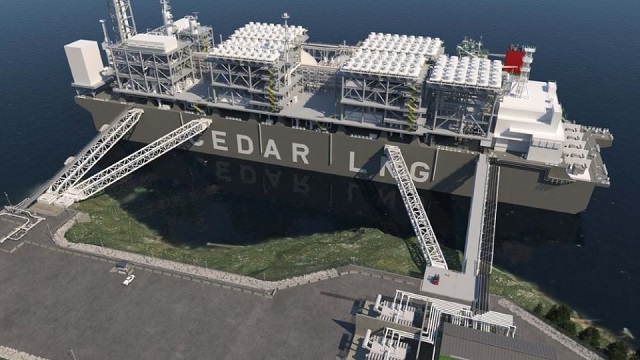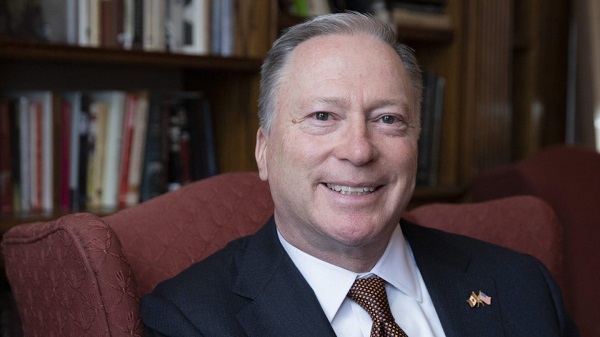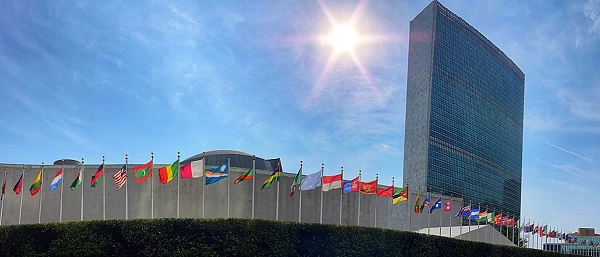Canadian Energy Centre
Opportunity knocks for Canada to become key LNG supplier as U.S. pauses projects

Rendering courtesy Cedar LNG
From the Canadian Energy Centre
By Cody Ciona
“Everyone wins if Canada can get into the game.”
Canada’s emerging liquefied natural gas (LNG) industry has an opportunity to become a key supplier for energy-hungry countries in Asia and beyond following the U.S. pause on new or pending LNG export approvals, industry watchers say.
With much of the world looking for alternatives to Russian natural gas following its invasion of Ukraine in 2022, the U.S. emerged as the number one global exporter of LNG. According to the International Energy Agency, the U.S. accounted for 80 per cent of additional supply in 2023.
But with the U.S. putting its LNG industry on pause, the timing could be good for Canada.
The recent completion of the Coastal Gaslink pipeline along with progress on Canada’s first LNG export projects are bringing Canada closer to becoming a key global supplier.
An opportunity to showcase clean LNG
As the LNG Canada terminal moves into its final stages of construction, Kitimat, B.C. will become the gateway for exports from Canada.
For First Nations LNG Alliance CEO Karen Ogen, this means Canada, which has so far missed the global LNG boom, will have another chance at becoming a player.
“I think this is an opportunity for us to showcase our clean LNG and I think we can do it through the various projects [underway].” Ogen said.
Those projects, which include LNG Canada and Woodfibre LNG that are under construction, along with the proposed Cedar LNG and Ksi Lisims LNG terminals, will operate with an emissions intensity less than half that of the global average.
Cedar LNG, headed by the Haisla First Nation, will operate at less than one-third of the global average.
Ogen said these projects will create significant prosperity, not just for Canada and B.C. but for Indigenous peoples as well.
“It’ll help boost our Canadian economy, it’ll help B.C.’s economy, and most specifically it will help the Indigenous people and our economy. If we’re the most disadvantaged population living in poverty, then this should help our people get out of poverty.” she said.
“Everyone wins if Canada can get into the game.”
Reduced LNG supply could increase reliance on coal
Racim Gribaa, founder and president of Global LNG Consulting Inc., said a potential decrease in LNG exports to international markets, particularly in Asia, may heighten dependence on coal, thereby escalating global emissions.
“If [importers] can’t get U.S. LNG, they would be left with very few viable alternatives including coal. And if they burn coal, that’s twice as much emissions. Coal is cheaper and reliable, but emits twice as much carbon. Countries in Asia such as China, with over 1,140 operational coal plants, are building new coal plants every week both in Asia and abroad,” Gribaa said.
Canada has a significant geographical advantage to supply LNG to Asia that can reduce associated transportation emissions by up to 60 per cent, he said.
Export terminals in B.C. are about half the distance to Asia compared to terminals on the U.S. Gulf Coast.
“The distance between Canada and the key market is a huge advantage, where we are the same distance to Asia as Australia,” Gribaa said.
“Monetizing natural gas in Canada through LNG exports not only will help reduce global emissions but it also will enhance health and economic well being of Canadians future generations.”
Establishing Canada’s LNG credibility
The starting point will be LNG Canada in 2025, which will allow Canada to export LNG on international scale, Gribaa said. It will help establish Canada’s credibility as a supplier, just as the U.S. pauses new development.
Once that credibility is established, Canadian LNG could become a bigger player on the global scale.
“Canada’s abundant natural gas reserves empower the nation to produce and export decades of dependable, cost-effective, and environmentally-friendly LNG to global markets, leveraging direct marine routes unaffected by constraints like the Panama or Suez Canals, the Strait of Hormuz, or having to navigate around the Cape of Good Hope,” Gribaa said.
“Canada stands poised to secure market share for years to come, irrespective of whether the U.S. temporarily halts or reconsiders its involvement.”
Alberta
Busting five myths about the Alberta oil sands

Construction of an oil sands SAGD production well pad in northern Alberta. Photo supplied to the Canadian Energy Centre
From the Canadian Energy Centre
The facts about one of Canada’s biggest industries
Alberta’s oil sands sector is one of Canada’s most important industries — and also one of its most misunderstood.
Here are five common myths, and the facts behind them.
Myth: Oil sands emissions are unchecked

Steam generators at a SAGD oil sands production site in northern Alberta. Photo courtesy Cenovus Energy
Reality: Oil sands emissions are strictly regulated and monitored. Producers are making improvements through innovation and efficiency.
The sector’s average emissions per barrel – already on par with the average oil consumed in the United States, according to S&P Global – continue to go down.
The province reports that oil sands emissions per barrel declined by 26 per cent per barrel from 2012 to 2023. At the same time, production increased by 96 per cent.
Analysts with S&P Global call this a “structural change” for the industry where production growth is beginning to rise faster than emissions growth.
The firm continues to anticipate a decrease in total oil sands emissions within the next few years.
The Pathways Alliance — companies representing about 95 per cent of oil sands activity — aims to significantly cut emissions from production through a major carbon capture and storage (CCS) project and other innovations.
Myth: There is no demand for oil sands production

Expanded export capacity at the Trans Mountain Westridge Terminal. Photo courtesy Trans Mountain Corporation
Reality: Demand for Canadian oil – which primarily comes from the oil sands – is strong and rising.
Today, America imports more than 80 per cent more oil from Canada than it did in 2010, according to the U.S. Energy Information Administration (EIA).
New global customers also now have access to Canadian oil thanks to the opening of the Trans Mountain pipeline expansion in 2024.
Exports to countries outside the U.S. increased by 180 per cent since the project went into service, reaching a record 525,000 barrels per day in July 2025, according to the Canada Energy Regulator.
The world’s appetite for oil keeps growing — and it’s not stopping anytime soon.
According to the latest EIA projections, the world will consume about 120 million barrels per day of oil and petroleum liquids in 2050, up from about 104 million barrels per day today.
Myth: Oil sands projects cost too much
Reality: Operating oil sands projects deliver some of the lowest-cost oil in North America, according to Enverus Intelligence Research.
Unlike U.S. shale plays, oil sands production is a long-life, low-decline “manufacturing” process without the treadmill of ongoing investment in new drilling, according to BMO Capital Markets.
Vast oil sands reserves support mining projects with no drilling, and the standard SAGD drilling method involves about 60 per cent fewer wells than the average shale play, BMO says.
After initial investment, Enverus says oil sands projects typically break even at less than US$50 per barrel WTI.
Myth: Indigenous communities don’t support the oil sands

Chief Greg Desjarlais of Frog Lake First Nation signs an agreement in September 2022 whereby 23 First Nations and Métis communities in Alberta acquired an 11.57 per cent ownership interest in seven Enbridge-operated oil sands pipelines for approximately $1 billion. Photo courtesy Enbridge
Reality: Indigenous communities play an important role in the oil sands sector through community agreements, business contracts and, increasingly, project equity ownership.
Oil sands producers spent an average of $1.8 billion per year with 180 Indigenous-affiliated vendors between 2021 and 2023, according to the Canadian Association of Petroleum Producers.
Indigenous communities are now owners of key projects that support the oil sands, including Suncor Energy’s East Tank Farm (49 per cent owned by two communities); the Northern Courier pipeline system (14 per cent owned by eight communities); and the Athabasca Trunkline, seven operating Enbridge oil sands pipelines (~12 per cent owned by 23 communities).
These partnerships strengthen Indigenous communities with long-term revenue, helping build economic reconciliation.
Myth: Oil sands development only benefits people in Alberta
Reality: Oil sands development benefits Canadians across the country through reliable energy supply, jobs, taxes and government revenues that help pay for services like roads, schools and hospitals.
The sector has contributed approximately $1 trillion to the Canadian economy over the past 25 years, according to analysis by the Macdonald-Laurier Institute (MLI).
That reflects total direct spending — including capital investment, operating costs, taxes and royalties — not profits or dividends for shareholders.
More than 2,300 companies outside of Alberta have had direct business with the oilsands, including over 1,300 in Ontario and almost 600 in Quebec, MLI said.
Energy products are by far Canada’s largest export, representing $196 billion, or about one-quarter of Canada’s total trade in 2024, according to Statistics Canada.
Led by the oil sands, Canada’s energy sector directly or indirectly employs more than 445,000 people across the country, according to Natural Resources Canada.
Alberta
Enbridge CEO says ‘there’s a good reason’ for Alberta to champion new oil pipeline

Enbridge CEO Greg Ebel. The company’s extensive pipeline network transports about 30 per cent of the oil produced in North America and nearly 20 per cent of the natural gas consumed in the United States. Photo courtesy Enbridge
From the Canadian Energy Centre
B.C. tanker ban an example of federal rules that have to change
The CEO of North America’s largest pipeline operator says Alberta’s move to champion a new oil pipeline to B.C.’s north coast makes sense.
“There’s a good reason the Alberta government has become proponent of a pipeline to the north coast of B.C.,” Enbridge CEO Greg Ebel told the Empire Club of Canada in Toronto the day after Alberta’s announcement.
“The previous [federal] government’s tanker ban effectively makes that export pipeline illegal. No company would build a pipeline to nowhere.”
It’s a big lost opportunity. With short shipping times to Asia, where oil demand is growing, ports on B.C.’s north coast offer a strong business case for Canadian exports. But only if tankers are allowed.
A new pipeline could generate economic benefits across Canada and, under Alberta’s plan, drive economic reconciliation with Indigenous communities.
Ebel said the tanker ban is an example of how policies have to change to allow Canada to maximize its economic potential.
Repealing the legislation is at the top of the list of needed changes Ebel and 94 other energy CEOs sent in a letter to Prime Minister Mark Carney in mid-September.
The federal government’s commitment to the tanker ban under former Prime Minister Justin Trudeau was a key factor in the cancellation of Enbridge’s Northern Gateway pipeline.
That project was originally targeted to go into service around 2016, with capacity to ship 525,000 barrels per day of Canadian oil to Asia.
“We have tried to build nation-building pipelines, and we have the scars to prove it. Five hundred million scars, to be quite honest,” Ebel said, referencing investment the company and its shareholders made advancing the project.
“Those are pensioners and retail investors and employees that took on that risk, and it was difficult,” he said.
For an industry proponent to step up to lead a new Canadian oil export pipeline, it would likely require “overwhelming government support and regulatory overhaul,” BMO Capital Markets said earlier this year.
Energy companies want to build in Canada, Ebel said.
“The energy sector is ready to invest, ready to partner, partner with Indigenous nations and deliver for the country,” he said.
“None of us is calling for weaker environmental oversight. Instead, we are urging government to adopt smarter, clearer, faster processes so that we can attract investment, take risks and build for tomorrow.”
This is the time for Canadians “to remind ourselves we should be the best at this,” Ebel said.
“We should lead the way and show the world how it’s done: wisely, responsibly, efficiently and effectively.”
With input from a technical advisory group that includes pipeline leaders and Indigenous relations experts, Alberta will undertake pre-feasibility work to identify the pipeline’s potential route and size, estimate costs, and begin early Indigenous engagement and partnership efforts.
The province aims to submit an application to the Federal Major Projects Office by spring 2026.
-

 Business2 days ago
Business2 days agoUN, Gates Foundation push for digital ID across 50 nations by 2028
-

 Alberta11 hours ago
Alberta11 hours agoClick here to help choose Alberta’s new licence plate design
-

 C2C Journal2 days ago
C2C Journal2 days agoCharlie Kirk and the Fragility of Civic Peace
-

 National12 hours ago
National12 hours agoDemocracy Watch Renews Push for Independent Prosecutor in SNC-Lavalin Case
-

 International2 days ago
International2 days agoPoland’s president signs new zero income tax law for parents with two children
-

 Business13 hours ago
Business13 hours agoOver two thirds of Canadians say Ottawa should reduce size of federal bureaucracy
-

 Business1 day ago
Business1 day agoTrump Admin Blows Up UN ‘Global Green New Scam’ Tax Push, Forcing Pullback
-

 Automotive2 days ago
Automotive2 days ago$15 Billion, Zero Assurances: Stellantis Abandons Brampton as Trudeau-Era Green Deal Collapses






